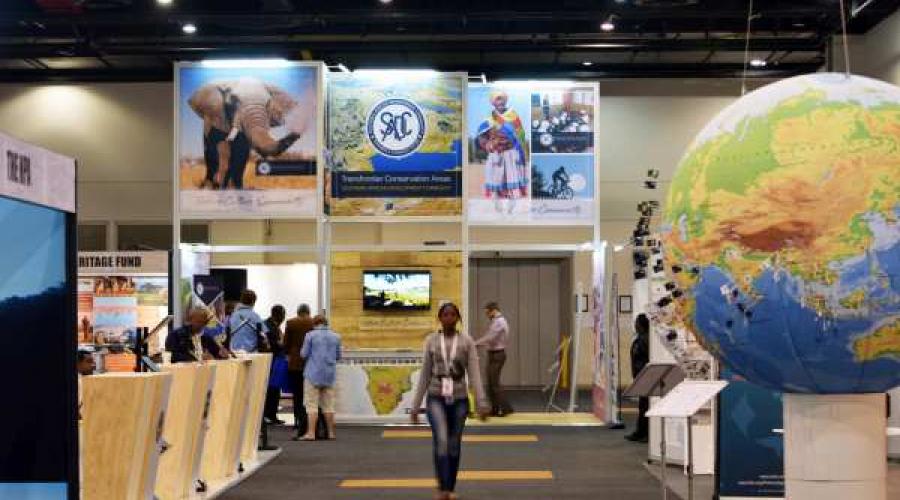Successful participation of SADC TFCA Network at CITES COP17
For two weeks the 17th Conference of the Parties (CoP17) to the Convention on International Trade in Endangered Species of Wild Fauna and Flora (CITES) took place in Johannesburg, South Africa. Bringing together over 3,500 representatives, 183 State Parties as well as conservation experts and community representatives, delegates negotiated on the regulated trade in endangered wild animals and plants species. The international conference, which comes amidst heightened international concern about the sustainability of wildlife resources, upon which livelihoods, national economies and regional security depend, considered 62 proposals affecting the international trade in close to 500 species.
Represented for the first time at a CITES CoP, the SADC TFCA Network demonstrated the importance of the establishment and development of Transfrontier Conservation Areas in the light of international commitments under CITES. At the CITES CoP with the highest number of side events and intense media interest from the entire region, the SADC TFCA Network together with the SADC Secretariat and various development partners and NGOs organized four topical side events. The well-attended events drew attention to the added value of cross-border collaboration through TFCAs in the field of species conservation, community engagement and cross-border law enforcement against poaching. Through a series of presentations and panel discussions the audience gained insight in and an understanding of the multi-dimensional approach of these conservation areas that straddle international borders. SADC TFCAs have a large role to play in species conservation. In light of shrinking spaces and corridors for wildlife, TFCAs are critical in re-establishing refuge and range for most of Africa’s iconic species. One highlight of this cross-border collaboration is the signing of Memorandum of Understanding (MoU) between South Africa and Mozambique which led to successful collaboration on a number of strategic anti-poaching activities. This MoU was initiated after the previous CoP Mozambique and South Africa were urged to further enhance bilateral co-operation to prevent a further increase in rhino poaching. The SADC Law Enforcement and Anti-Poaching Strategy was also for the first time presented to a wider audience at CITES COP17.
The side events benefitted from official participation, demonstrating that SADC Member States are at the helm of such worthwhile initiatives, steering TFCAs towards long term success for the conservation of species, socio-economic development and regional integration.
In addition to the side events, the SADC TFCA Network showcased cross-border conservation efforts in SADC through a SADC TFCA exhibition booth. TFCA practitioners from all over the SADC region could answer questions of the public and presented the challenges and accomplishments TFCAs face in their development. The exhibition booth became a vibrant meeting point for those interested in cross-border protection of the environment as well as rural economic development. High-level visitors, such as SADC Ministers of Environment, CITES Secretary-General as well as other high officials also visited the exhibition booth and participated in lively discussions. The German Development Cooperation through GIZ and KfW as well as Peace Parks Foundation, the USAID Programme RESILIM, IUCN BIOPAMA and Boundless Southern Africa supported the SADC TFCA Network and SADC Secretariat in their in their endevour.
Following two weeks of marathon negotiations, the worlds' governments adopted a suite of groundbreaking decisions on regulating legal, sustainable and traceable trade in wildlife. This included strengthened actions to combat illicit wildlife trafficking, higher protection to entire groups of species, targeted demand reduction strategies for illegally traded wildlife, and an agreement on closer engagement with rural communities.
Some other important decisions include the transfer of the endangered African grey parrot, all eight pangolin species and Barbary macaque monkeys to Appendix I of the convention, meaning they may no longer be internationally traded for commerce. The Silky shark, Thresher sharks and Devil rays have been included in Appendix II, allowing trade only with special permits and calling for certain monitoring measures to be put in place. A bid by Swaziland to allow it to trade rhino horn was rejected; while a proposal to have the elephant populations of Namibia, South Africa, Botswana and Zimbabwe moved to Appendix I was also defeated.
John E. Scanlon, CITES Secretary-General concluded: “It was here in Johannesburg that rural community voices and the voice of the world’s youth came into the heart of the meeting room to be heard by decision makers from across the world. It has been a truly wonderful CoP from every perspective for which we extend our deepest gratitude to the Government and the people of South Africa”


